![]()
![]()
![]()
Use LEFT and RIGHT arrow keys to navigate between flashcards;
Use UP and DOWN arrow keys to flip the card;
H to show hint;
A reads text to speech;
50 Cards in this Set
- Front
- Back
- 3rd side (hint)
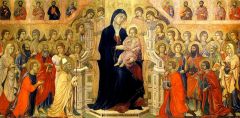
What Is this?
|
Duccio, Maesta Altarpiece,
1308-11 (14th C Italian Renaissance) |
|
|

Whats Is This?
|
Simoni Martini, Annunciation
1333(14th C Italian Renaissance) -Olive Branch |
|
|

?
|
Masaccio, Holy Trinity 1428
(15th C Italian Renaisance) -Memento Mori |
|
|

?
|
Paolo Uccello, The Battle of San Romano, 1455
(15th C Italian Renaissance) |
|
|

?
|
Piero della Francesca, Madonna and Child with Saints and the Duke of Urbino, 1472-74 (15th Italian Renaissance)
-Sacra Conversacione |
|
|
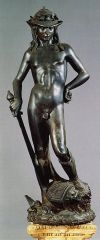
?
|
Donatello, David 1470
15th century Italian Renaissance |
|
|

?
|
Verrocchio, David, 1470 (15th C Italian Renaissance)
|
|
|
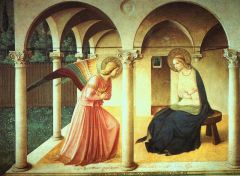
?
|
Fra Angelico, Annunciation, 1440 (15th C Italian Renaissance)
|
|
|
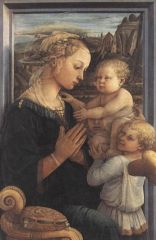
?
|
Fra. Filippo Lippi, Madonna and Child, 1455 (15th C Italian Renaissance)
|
|
|

?
|
Leonardo da Vinci, Mona Lisa, 1503-06 (High Renaissance)
-Sfumato |
|
|
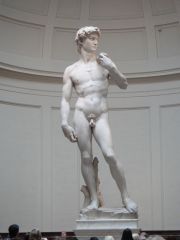
?
|
Michelangelo, David, 1501-1504 (High Renaissance)
|
|
|

?
|
Raphael, Madonna of the Meadow, 1505 (High Renaissance)
-Chiaroscuro |
|
|

?
|
Giorgione, The Tempest, 1510 (High Renaissance- Venetian School)
-Cabinet Paintings |
|
|
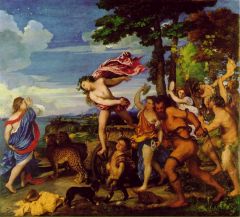
?
|
Titian, Meeting of Bacchus and Ariadne, 1522 (High Renaissance- Venetian School)
|
|
|
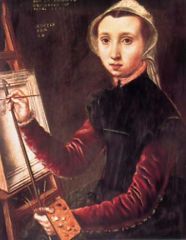
?
|
Caterina van Hemessen, Self-Portrait, 1548 (16th C Northern Renaissance)
-Maulstick |
|
|

?
|
Gianlorenzo Bernini, Baldacchino, St. Peter’s, Rome, 1624-33 (Italian Baroque)
|
|
|
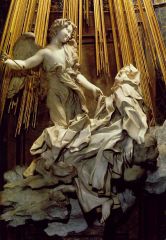
?
|
Gianlorenzo Bernini, Ecstasy of Saint Teresa, 1645-1652 (Italian Baroque)
|
|
|
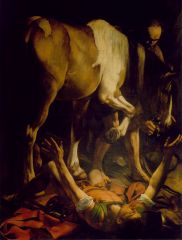
?
|
Caravaggio, Conversion of St. Paul, ca. 1601 (Italian Baroque)
|
|
|
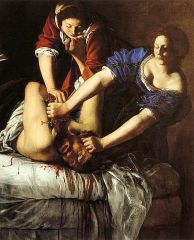
?
|
Artemesia Gentileschi, Judith Slaying Holofernes, 1614-1620 (Italian Baroque)
|
|
|
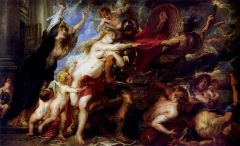
?
|
Peter Paul Rubens, Allegory of the Outbreak of War, 1638 (Flemish Baroque)
-Flanders |
|
|
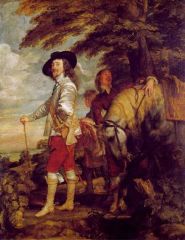
?
|
Anthony van Dyck, Charles I Dismounted, 1635 (Flemish Baroque)
|
|
|
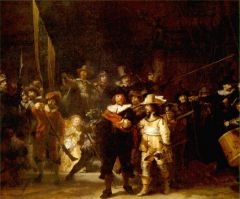
?
|
Rembrandt, Night Watch, 1642 (Dutch Baroque)
|
|
|
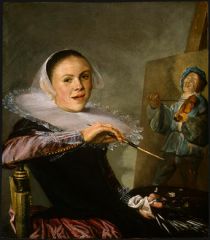
?
|
Judith Leyster, Self-Portrait, 1630 (Dutch Baroque)
|
|
|
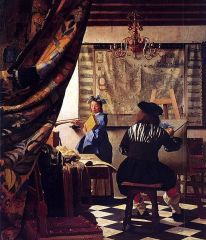
?
|
Jan Vermeer, Allegory of the Art of Painting, 1670-75 (Dutch Baroque)
-Narrative |
|
|
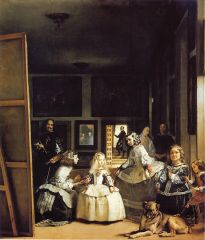
?
|
Diego Velázquez, Las Meninas, 1656 (Spanish Baroque)
|
|
|
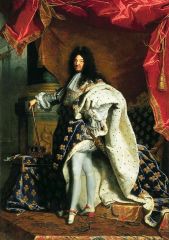
?
|
Hyacinthe Riguad, Louis XIV, 1701 (French Baroque)
|
|
|

?
|
Jan Van Eyck, The Arnolfini Wedding, 1433 (15th C Northern Renaissance)
|
-Dog: loyalty
-red curtains might allude to the physical act of love between the married couple -The chandelier has one lit candle signifying matrimony and the unity of marriage -The spotless convex mirror on the back wall alludes to purity, and the reflection of two other individuals in the room (including the painter) infers that witnesses are present |
|

?
|
Hieronymous Bosch, Garden of Earthly Delights, 1500 (15th C Northern Renaissance)
|
-fruits:another term for sex
-dog:loyalty -oyster-sex -owl |
|
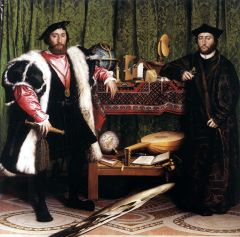
?
|
Hans Holbein the Younger, The French Ambassadors, 1533 (16th C Northern Renaissance)
|
-right man-long coat, man of the church
-left man of world-short coat -charm on neck orders St. Michael, opposed to division of church -anamorphic skull- vanitas "everything passes" |
|

?
|
Pieter Aertsen, Meat Still-Life, 1551 (16th C Northern Renaissance)
|
-Pretzel crossed fish: spiritual food
-mary joseph -otherside glutony & life of pursuit -oyster |
|
|
maesta
|
majesty, used for depiction of the Virgin Mary
|
|
|
|
vanitas
|
type of symbolic art (still life) flourished in neverlands and flanders in 16 and 17 centuries
"everything passes" |
|
|
|
mannerism
|
later Renaissance art that emphasized "artifice," contrived gesture, costume not naturally appearing: polish, self-consciousness, fantasy, fluidity, symmetry, even parody of such people, gestures, and situations
|
|
|
|
memento mori
|
symbol or "reminder" of death, usually a skull
|
|
|
|
Sfumato
|
smoky haziness used to soften lines in paintings, especially Leonardo and Corregio
|
|
|
|
tempera
|
color derived from mixing egg yolk, glue, pigment, and/or casein (milk protein)
|
|
|
|
Fresco
|
wet plaster cistine chapel
|
|
|
|
Reformation
|
North broke away from catholic church, started by Martin Luther
|
|
|
|
Counter- reformation
|
Catholic Church tried getting people back recognized they were messed up, influence through art
|
|
|
|
Flander
|
Flemish Art
|
|
|
|
Maniera Greca
|
byzantine style
-no portraits -little naturalism -Gold |
|
|
|
Stigmata
|
Jesus Christ Nails
St. Francis Assis |
|
|
|
Grisailles
|
Stone Like
|
|
|
|
Guilds
|
Training Artists
|
|
|
|
Humanism
|
Classical Antigua
|
|
|
|
High Renaissance
|
1500-1520
|
|
|
|
Differences between Italian and Northern Art and their depictions of the human form
|
Italian Renaissance artists in the South had an instinctive understanding of the human form and its beauty. Northern Renaissance artists were never comfortable with the depiction of the human form. They had differences in artistic style and artistic intentions. Italian artists would have viewed Grunewald' and Bosch's works as fantastic and devoid of order or any theory based on the observation of nature.
|
Northern Renaissance was characterized by Use of the qualities of fantasy, imagination, expression create the appearance of Northern Renaissance Art to look abstract, expressionistic, and individualistic in its use of line and color. Norther Renaissance artists had an instinctive feel for color and line. they used color and line for expressive purposes, for emotion, imagination, and fantasy.
|
|
|
Factors that contributed to the rise of Renaissance culture
|
-New Secular Hunger for Discovering Texts
-Reintroduction of Classical Works -The Political Situation: The Need for Display and Administration -New Wealth and the Black Death -Development of Renaissance Humanism -Peace and War |
|
|
|
The differences between tempera and oil paint and the effect of oil paint on Renaissance art
|
Tempera was egg based paint,it could not be stored so each color had to made on spot. Had to mix exact amount of paint cause matching it was difficult. Renaissance took hold, artists became more interested in describing what the world around them looked like in their paintings. As landscapes and real people began to appear in paintings, the problem of tempera became more apparent. Oil paint provided a solution.
|
|
|
|
The purpose and aims of the Counter Reformation and its influence on art history
|
Bring people back that had left because of the reformation and and they did a lot of trough the art influence.
|
|

